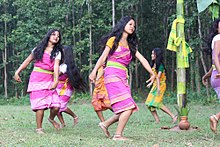
Back কোচ ৰাজবংশী Assamese রাজবংশী Bengali/Bangla Koch-Rajbongshi Catalan कोच राजबोंग्शी लोग Hindi Koch Rajbongshi Italian ᱨᱟᱡᱽᱵᱚᱝᱥᱤ ᱡᱟ.ᱛᱤ SAT Rajbanshi people SIMPLE
This article contains too many or overly lengthy quotations. (May 2024) |
 Rajbanshi women dancing in Assam, India | |
| Regions with significant populations | |
|---|---|
Assam | 7,021,254 (2011)[1][2] |
| West Bengal | 3,983,316 (2011)[2][3][1][4] |
| Bihar | 290,079 (2023)[5] |
| 127,985 (2021)[6] | |
| 13,193 (2022)[7] | |
| Languages | |
| Rajbanshi, Assamese, Bengali, Nepali | |
| Religion | |
| Hinduism | |
| Related ethnic groups | |
| Nashya Shaikh, Koch, Rabhas, Garos, Boros, Mech, Tharu other Indo-Aryan people | |
| Part of a series on the |
| Culture of Assam |
|---|
 |
The Rajbanshi, also Rajbongshi and Koch-Rajbongshi,[11] are peoples from Lower Assam, North Bengal, eastern Bihar, Terai region of eastern Nepal, Rangpur division of North Bangladesh and Bhutan[12] who have in the past sought an association with the Koch dynasty.[13] Koch-Rajbanshi people speak Kamatapuri,[14] an Indo-Aryan language, likely due to language shift, and in the past they might have spoken Tibeto-Burman languages. The community is categorised as OBC in Assam and Bihar, and SC in West Bengal.[1] In Nepal they are considered part of the Plains Janjati. In Bangladesh the community is classified as Plains ethnic group under 'Barman'. They are the largest Scheduled Caste community of West Bengal.[15]
In 2020, Kamatapur Autonomous Council has been created for socio-economic development and political rights of Koch-Rajbongshi community residing in Assam.[16]
They are related to the ethnic Koch people found in Meghalaya but are distinguished from them as well as from the Hindu caste called Koch in Upper Assam that receives converts from different tribes.[17] Rajbanshi (of royal lineage) alludes to the community's claimed connection with the Koch dynasty.[13]
- ^ a b c Tewari, Ruhi; Das, Madhuparna (14 April 2021). "Who are Rajbanshis, caught in Shah-Mamata scrap & why they're key for BJP in Assam, Bengal". ThePrint. Archived from the original on 9 July 2021. Retrieved 7 January 2025.
- ^ a b "Tribal Development Department, Government of West Bengal".
- ^ Pandey, Neelam; Das, Madhuparna (4 May 2021). "Matuas & Rajbanshis of Bengal both want CAA. So, why did one vote for BJP & not the other?". ThePrint. Retrieved 7 January 2025.
- ^ "West Bengal - Data Highlights: The Scheduled Castes -Census of India 2001" (PDF). censusindia.gov.in. Retrieved 17 August 2020.
- ^ Verma, Ritesh (3 November 2023). "Bihar Caste Wise Population Share Full List: बिहार में किस जाति की कितनी संख्या, आबादी में कितना प्रतिशत हिस्सेदारी". Hindustan (in Hindi). Retrieved 6 November 2023.
- ^ National Statistics Office (2021). National Population and Housing Census 2021, Caste/Ethnicity Report. Government of Nepal (Report).
- ^ "Table 1.4 Ethnic Population by Group and Sex" (PDF). Bangladesh Bureau of Statistics. 2021. p. 33. Archived (PDF) from the original on 15 March 2023. Retrieved 22 November 2022.
- ^ "639 Identifier Documentation: aho – ISO 639-3". SIL International (formerly known as the Summer Institute of Linguistics). SIL International. Retrieved 29 June 2019.
Ahom [aho]
- ^ "Population by Religious Communities". Census India – 2001. Ministry of Home Affairs, Government of India. Retrieved 1 July 2019.
Census Data Finder/C Series/Population by Religious Communities
- ^ "Population by religion community – 2011". Census of India, 2011. The Registrar General & Census Commissioner, India. Archived from the original on 25 August 2015.
2011census/C-01/DDW00C-01 MDDS.XLS
- ^ "In West Bengal and Bihar, they are known as "Rajbongshi and "Rajbanshi", " in Assam as "Koch," and "Koch-Rajbongshi," and in Meghalaya mainly as "Koch." (Roy 2018)
- ^ "The Rajbanshi as a social and cultural group are well-known to historians, sociologists and anthropologists working on northeast India. They are also familiar to those who focus on the issues surrounding minorities and indigenous groups (compare Berlie, 1982; Bessaignet, 1964; Shrestha, 2009; Wilson, 2012). A sizeable population, they are mostly concentrated in the northern parts of West Bengal and western Assam in India, in northwest Bangladesh, and the Jhapa and Morang Districts of Nepal. Although this article focuses primarily on those living in northeast India, and despite variations identified in the anthropological literature, Rajbanshi inhabiting Nepal and Bangladesh (also Bhutan and Tibet) very likely share a common historical consciousness and folklore with theirIndian kin (Das, 2009)."(Wilson & Bashir 2016:457)
- ^ a b Cite error: The named reference
Ramirez-14was invoked but never defined (see the help page). - ^ An early investigation of Rajbanshi language appears in the Linguistic Survey of India, published by Grierson during the colonial period...Accordingly, Das sees no value (beyond the political) in considering Rajbanshi (or Kamtapuri/Kamata, as it is also called) as a distinct dialect.(Wilson & Bashir 2016:460)
- ^ Chaubey, Santosh (17 March 2021). "The Significance Of Matuas and Rajbanshis in West Bengal Poll Battle, Explained". News18. Retrieved 6 August 2023.
- ^ "The Kamatapur Autonomous Council Act 2020" (PDF). Legislative Department. 19 October 2020. Retrieved 18 July 2022.
An Act to provide for the establishment of an Administrative Authority in the name and style of the Kamatapur Autonomous Council and for matters incidental therein and connected therewith
- ^ "The Koch of western Meghalaya also claim relationship with those empire-building Koch. On the other hand, Koch is known as a Hindu caste found all over the Brahmaputra Valley (Majumdar 1984: 147), and receives converts to Hinduism from different tribes (Gait 1933: 43)." (Kondakov 2013:4)